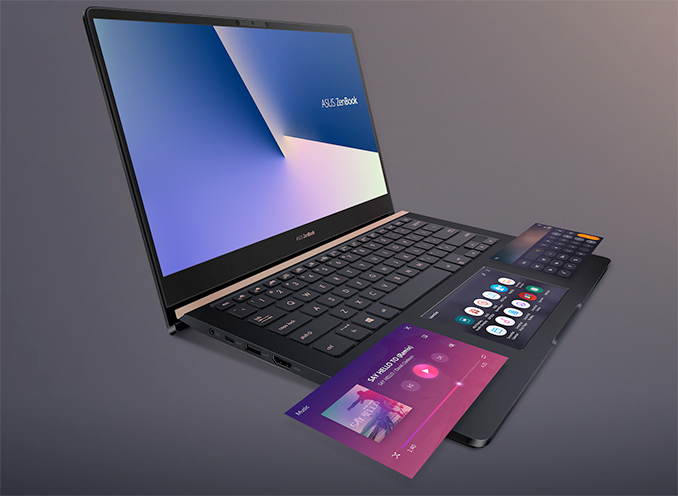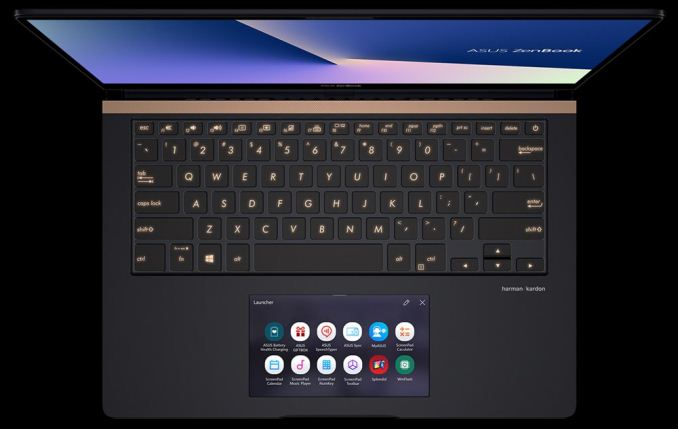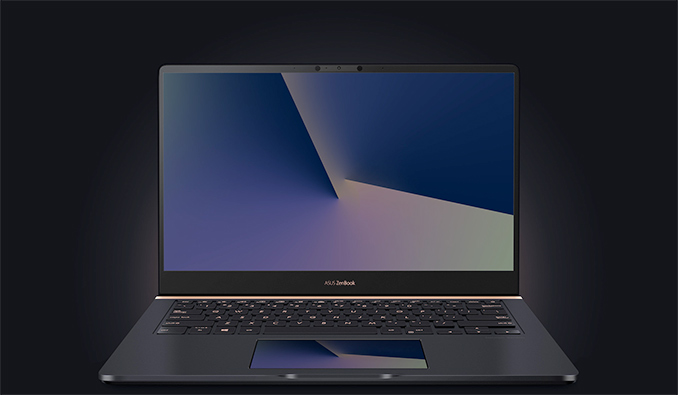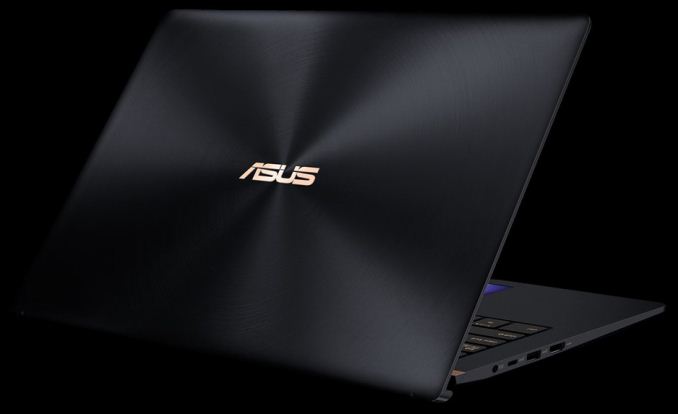ASUS Details ZenBook Pro UX480 with ScreenPad, Whiskey Lake, & dGPU
by Anton Shilov on August 31, 2018 10:05 AM EST- Posted in
- IFA 2018
- Asus
- Laptops
- Trade Shows
- Pascal
- Max-Q
- Whiskey Lake
- ZenBook Pro

ASUS at IFA formally introduced its 14-inch ZenBook Pro UX480 laptop featuring the company’s ScreenPad, a touchpad with a built-in display. The notebook was demonstrated back in early June at Computex, but ASUS never disclosed its specs nor an availability timeframe. As it appears, the mobile PC is powered by Intel’s latest Whiskey Lake-U processor accompanied by NVIDIA’s GeForce GTX dGPU. ASUS intends to start selling the product sometimes in late October.
The ZenBook Pro is a relatively new lineup in ASUS’ product range that is aimed at users demanding performance, portability, and style. Initially, ASUS introduced 15.6-inch versions of its ZenBook Pro laptops, but with the ZenBook Pro 14 UX480 it is adding 14-inch models into the family. Since the system is smaller, ASUS has to use components with a lower TDP, and possibly reduce the count of components in general. This however does not mean that the new system has to make compromises in terms of performance or key features. The ZenBook Pro 14 comes with Intel’s quad-core Core i5/i7 (Whiskey Lake-U) processor, NVIDIA’s discrete GeForce GTX 1050 GPU with Max-Q software, as well as ASUS’ 5.5-inch ScreenPad that can simplify usage of certain programs or even act like a second screen for applications that support it.
At least initially, ASUS will offer its ZenBook Pro 14 with a Full-HD multi-touch display that supports 100% of the sRGB color gamut, and is factory-calibrated to DeltaE accuracy of < 3.
As for DRAM and storage, the ZenBook Pro 14 will ship with either 8 or 16 GB DDR4-2400, as well as an SSD featuring 128GB to 1TB of capacity with a SATA or a PCIe interface. Interestingly, only the 1TB SSD variant inside the UX480 will use a PCIe 3.0 x4 interface, whereas the more popular 256 GB and 512 GB capacities will come with a PCIe 3.0 x2 or a SATA interface, which will therefore offer considerably lower performance. Furthermore, inexpensive versions of the ZenBook Pro 14 will be equipped with a hard drive and an Intel Optane Memory caching SSD.
The I/O capabilities of the ZenBook Pro 14 resemble those of higher-end ZenBook Pro 15 models, though the smaller PC lacks Thunderbolt 3. On the wireless connectivity side of things, we see Intel’s Wireless-AC 9560 CNVi solution featuring 802.11ac Wi-Fi (with up to 1.73 Gbps throughput over 160 MHz) and Bluetooth 5.0.
As for physical ports, the notebook is equipped with two USB 3.0 connectors (Type-A and Type-C), one USB 2.0 port, a HDMI display output, a microSD card reader, a TRRS audio jack, and a proprietary jack for charging. As for conferencing, the laptop has a VGA webcam with IR sensors for Windows Hello, Harman Kardon-badged stereo speakers with a ‘smart’ amplifier, and a microphone array.
When it comes to battery, the ZenBook Pro 14 is outfitted with a 70 Wh battery that enables 12.5 hours of autonomous operation and can fast charge from empty to 60% in 49 minutes.
Traditionally for ZenBooks, the ZenBook Pro 14 comes in an aluminum chassis with Deep Dive Blue finish with Rose Gold inlays. ASUS says that the chassis meets the MIL-STD 810G standard for reliability/durability, and can survive drops, vibrations, high/low temperatures, and so on.
The laptop features a 17.9-mm z-height and weighs 1.6 kilograms, which is not particularly thin or very light for a 14-inch laptop. In the meantime, since we are dealing with a notebook that has a discrete GPU, is able to accommodate a hard drive, is equipped with a ScreenPad (which adds the weight of the extra display module and its protective glass), and features a high-capacity battery, the weight and thickness are not particularly surprising.
As noted above, ASUS will start selling its ZenBook Pro 14 (UX480) starting from late October. Considering that there will be multiple configurations available, pricing of the new notebooks will vary greatly depending on exact configuration.
| General Specifications of the ASUS ZenBook Pro 14 | ||
| UX480 | ||
| LCD | Diagonal | 14" |
| Details | 1920×1080 | 100% sRGB | |
| Multi-Touch | 10-point multi-touch | |
| Screenpad | Diagonal | 5.5" |
| Type | Super IPS+ | |
| Resolution | 1920×1080 | |
| CPU Options | Core i7-8565U (4C/8T, 1.8 - 4.6 GHz, 8 MB, 15 W) Core i5-8265U (4C/8T, 1.6 - 3.9 GHz, 6 MB, 15 W) |
|
| Graphics | Integrated | HD Graphics 620 (24 EUs) |
| Discrete | NVIDIA GeForce GTX 1050 Max-Q 2 or 4 GB GDDR5 memory GP107, 640 SPs |
|
| RAM | 8 or 16 GB DDR4-2400 | |
| Storage | Options | 128 or 256 GB SATA SSD 256 or 512 GB PCIe 3.0 x2 SSD 1 TB PCIe 3.0 x4 SSD HDD with Intel Optane Memory caching SSD |
| Wireless | Wi-Fi | Intel Wireless-AC 9560 CRF 802.11ac (2x2) Wi-Fi |
| Bluetooth | Bluetooth 5.0 | |
| USB | 2.0 | 1 × USB Type-A |
| 3.1 Gen 2 | 1 × USB Type-C 1 × USB Type-A |
|
| Thunderbolt | 2 × TB 3 (data, DP displays) | |
| Display Outputs | 1 × HDMI | |
| Gigabit Ethernet | optional USB to LAN port dongle | |
| Card Reader | MicroSD card reader | |
| Webcam | Webcam with IR sensors for Windows Hello | |
| Fingerprint Sensor | No | |
| Other I/O | Microphone, stereo speakers, audio jack | |
| Battery | 70 Wh, 12.5 hours battery life | |
| Dimensions | Width | 32.3 cm | 12.71 inch |
| Depth | 22.5 cm | 8.85 inch | |
| Thickness | 1.79 cm | 0.7 inch | |
| Weight | 1.6 kilograms | 3.52 lbs | |
| Price | $? | |
Related Reading:
Source: ASUS














12 Comments
View All Comments
Doroga - Friday, August 31, 2018 - link
"The I/O capabilities of the ZenBook Pro 14 resemble those of higher-end ZenBook Pro 15 models, though the smaller PC lacks Thunderbolt 3."And then specs table says:
"Thunderbolt 2 × TB 3 (data, DP displays)"
jeremyshaw - Friday, August 31, 2018 - link
The source website also doesn't state 2.5" HDD compatibility.Daniel Egger - Friday, August 31, 2018 - link
Yeah, on top of that they left out pretty much everything that makes the Pro 15 worth buying. I guess I don't really see the point of the Pro 14.ajp_anton - Friday, August 31, 2018 - link
Text says it "lacks Thunderbolt 3". Specs says it has "2 × TB 3"jvl - Friday, August 31, 2018 - link
So I guess Asus beat Apple to it. So much..timecop1818 - Friday, August 31, 2018 - link
garbage screen and garbage keyboard. touchpad screen is a solution looking for a problem.V900 - Monday, September 3, 2018 - link
Hehe...Compared to Apples keyboards, that are so brilliantly designed, that a simple speck of dust can result in a non-functioning keyboard and a 500-1000$ repair bill, even an Asus keyboard seems like an improvement.
zodiacfml - Saturday, September 1, 2018 - link
Looks more useful than Apple's touchbar.I wonder how they implemented this. More likely, it will appear as a second display in Windows.
Aside from shortcuts, I might be able to use it as a true second screen, monitoring prices or CCTV cameras.
V900 - Monday, September 3, 2018 - link
Yup... The Touchbar is one of those ideas that sound great in a presentation, but IRL use is pretty meh. Like Face ID.Apple seems to have lost their touch lately. Jobs wouldn’t have approved of many of their recent decisions.
hanselltc - Saturday, September 1, 2018 - link
Oh shit these are so perfect for my use. Too bad it'll probably end up too expensive.